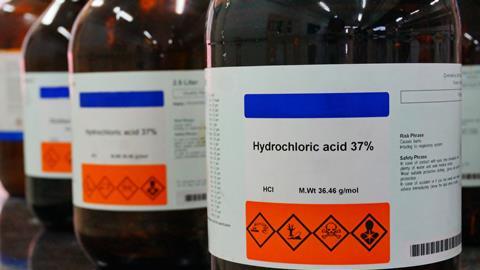Meera Senthilingam
This week, an acidic compound used throughout history, throughout industry and also by our bodies. Here's Brian Clegg:
Brian Clegg
Most of us first come across the trio of strong acids - hydrochloric, nitric and sulphuric - when we venture into a chemistry lab at school. They aren't the kind of substances you find in the kitchen cupboard at home. Yet I can guarantee that one of these compounds has been part of your life every day since you were a baby. Because hydrochloric acid plays an essential role in your body.

This powerful acid, an aquatic solution of hydrogen chloride, has been known for a long time. The acid's early names have a rather nautical flavour, reflecting the production of the acid from common salt. The alchemists would have called it 'spirits of salt' while its common name before modern conventions came in was muriatic acid, where 'muriatic' was a fancy term for briny. As one N. Grew put it in 1675 'Muriatick is Saltness joyned with some Pungency'.
Exactly when hydrochloric acid was first prepared is not clear. The alchemists tended to produce mixtures that could well have contained hydrochloric acid, and some have suggested that Jabir ibn Hayyan had produced it as early as the ninth century. It would certainly have been in use in aqua regia, a mix of hydrochloric and nitric acids, in the medieval period. We do know that one of Joseph Priestley's 1772 gas experiments produced pure hydrogen chloride gas, and that Humphry Davy successfully showed that the compound contained hydrogen and chlorine in 1818.

We tend, rather loosely to refer to hydrochloric acid as HCl, but when hydrogen chloride dissolves in water, the positive hydrogen ion combines with water's H2O to produce hydronium (H3O+), leaving a negative chloride ion. Concentrated hydrochloric acid is around 38% hydrogen chloride.
Originally, most industrial hydrogen chloride was a waste product that was pumped out into the air, but by the mid-nineteenth century the level of pollution was no longer considered acceptable. Fortunately, by this time the waste hydrogen chloride had become valuable for producing hydrochloric acid. Although the processes involved have changed, shifting from a by-product of sodium carbonate production to chiefly being produced alongside organic compounds, hydrochloric acid is still mostly the reuse of a waste product, the marmite of the acid world.
Much of the industrial production of hydrochloric acid goes into pickling and is used in various chemical manufacturing processes. The pickling in question doesn't involve onions, but is a way of removing surface discolouration from steel and other metals.
In industrial chemical processes, hydrochloric acid is used to produce molecules containing chlorine for plastic products, such as diochloroethane and vinyl chloride (used to make PVC). Because a lot of the world's hydrogen chloride production takes place as a by-product of other chemical processes, the hydrochloric acid is often made and consumed on site, effectively being recycled in the process, rather than ever becoming a separate commercial product.
Although hydrochloric acid does play a part in the food industry, where it is used to control the pH of water in food production, it has a much more fundamental part to play when it comes to the consumption of food. Your stomach contains a sizeable quantity of hydrochloric acid and can have a pH as low as 1.

Part of the role of this powerful acid is to prevent infection, but its main function is in digestion. The acid attacks proteins in a process known as denaturing, which causes them to unravel, making them more readily broken down by enzymes for digestion. Perhaps the most familiar example of denaturation is the way an egg white's proteins are denatured by cooking, going from a transparent liquid to an opaque solid. Here the breakdown in structure results in the formation of a tangled mass of denatured protein, but in the stomach, the result is to do the initial demolition work to enable enzymes like pepsin to pull apart proteins into smaller fragments.
Your stomach itself is protected from the acid it contains by a thick layer of mucus, while a powerful muscle keeps the top of the stomach closed off. But the mechanisms involved can sometimes go wrong, resulting in acid being released into the oesophagus to produce the burning sensation of acid reflux, or simply to cause indigestion within the stomach.
Although there are now sophisticated drugs that reduce the production of acid in the first place, many of us still resort to a basic inorganic chemical reaction and swallow a couple of antacid tablets when suffering stomach troubles. There are various remedies on the market, but many contain calcium or magnesium carbonate, resulting in a simple reaction that neutralises the acid, producing a chloride, water and carbon dioxide.
Whether it's cleaning rusty metal, producing PVC or breaking down proteins, hydrochloric acid is the workhorse compound that simply gets on with the job. Hydrochloric acid may be responsible for uncomfortable nights when we've eaten too much and suffer the consequences of excess acid in the stomach, but that's more than compensated for by its everyday role in turning food into fuel.
Meera Senthilingam
And as that fuel is what gets us throught the day, I'm sure we can forgive a few sleepless nights from indigestion. That was science writer Brian Clegg with the chemistry behind the widely-used and possibly under-appreciated compound, hydrochlric acid. Now, given how much we all like to eat, next week we meet the compound at the source of all that food.
Duncan McMillan
It is truth probably not acknowledged enough, that we owe our existence, and the web of life that sustains us, to food produced by light. At the bottom of nearly every tree of life, from tundra to savannah to coral reef and ocean trench, a photosynthetic organism is doing all the heavy lifting. And the molecule that makes it happen is chlorophyll.
Meera Senthilingam
And to find out just how just how chlorophyll uses light to produce food and how this compound has also inspired centuries' worth of notable artists due to its use in a certain spirit, join Dincan McMillan in next week's Chemistry in it's element. Until then, thank you for listening. I'm Meera Senthilingam.













No comments yet